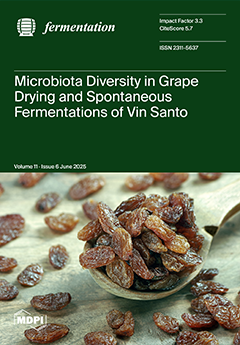This study reports the effects of pH culture on multi-biofuel production (hydrogen, ethanol, and 2,3-butanediol) by
Enterobacter cloacae K1ga, isolated from koala and adapted to grow in 100 g dm
−3 glucose. Batch cultures were performed in 1 dm
3 bioreactors, controlling
[...] Read more.
This study reports the effects of pH culture on multi-biofuel production (hydrogen, ethanol, and 2,3-butanediol) by
Enterobacter cloacae K1ga, isolated from koala and adapted to grow in 100 g dm
−3 glucose. Batch cultures were performed in 1 dm
3 bioreactors, controlling the pH at 5.5, 6.5, 7.5, and 9.2. Furthermore, cultures without pH control (with an initial pH of 9.2) were used as reference cultures. Controlling pH at 9.2 was detrimental to
E. cloacae K1ga as no growth or biofuel production was observed. In contrast, reference cultures reached a maximum 2,3-butanediol (BDO) production (BDOP) of 22.9 ± 2.1 g dm
−3 and ethanol production (EP) of 9.9 ± 0.7 g dm
−3 and the highest hydrogen production (HP) of 2013.1 ± 275.7 cm
3 dm
−3. Meanwhile, a pH of 7.5 increased the accumulation of ethanol, obtaining the highest EP (14.0 ± 0.05 g dm
−3). On the contrary, a pH of 5.5 was unfavourable for the fermentative metabolism of
E. cloacae K1ga, showing the lowest production rates for the three biofuels and also the lowest EP (8.05 ± 0.35 g dm
−3). The results demonstrate that the natural progression of pH during the growth of
E. cloacae K1ga is an advantageous strategy for multi-biofuel production, since no tight pH control system is required.
Full article





